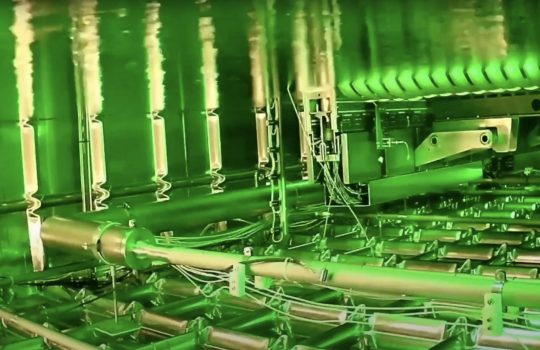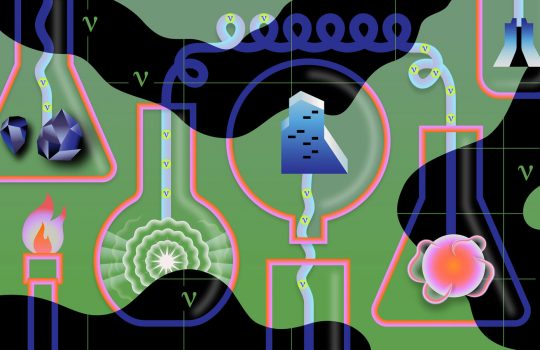A newly awarded multi-year contract for the acquisition of a large cryogenic plant to cool tens of thousands of tons of liquid argon brings the Deep Underground Neutrino Experiment one step closer to realization.
DUNE and its cryogenic plant will be assembled in the Long-Baseline Neutrino Facility, an ambitious project hosted by the U.S. Department of Energy’s Fermi National Accelerator Laboratory. The experiment will explore the mysterious behavior of elementary particles called neutrinos in more detail than ever before. A neutrino beam powered by Fermilab’s PIP-II accelerator will travel about 1,300 kilometers (about 800 miles) through the earth to the massive, liquid-argon-filled neutrino detectors in the LBNF caverns in South Dakota, located at the Sanford Underground Research Facility.
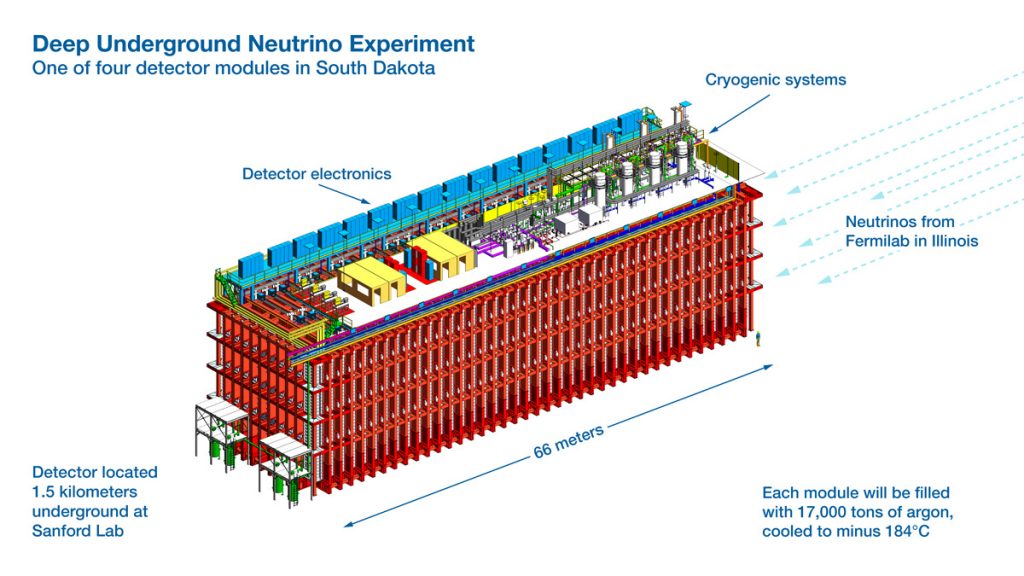
One of the DUNE detector modules that will be assembled a mile underground and filled with 17,500 metric tons of liquid argon. Image: Fermilab
Providing the equipment for the cooling of the 17,500 metric tons of liquid argon in each of the large cryostats of the far detector modules is the sizeable task of Air Products, an industrial gases company based in Allentown, Pennsylvania. The overall scope of this contract includes the engineering, manufacturing, installing and commissioning of a liquid nitrogen refrigeration system to cool down and keep the argon at minus 186 degrees Celsius, or minus 303 degrees Fahrenheit. Both the nitrogen and argon systems will be closed systems — neither will actively vent into the environment.
Argon is a noble gas about 10 times heavier than its groupmate helium. It becomes a liquid at low temperature. The liquid nitrogen refrigeration system will cool the argon in the DUNE detectors while the argon flows through a separate, closed loop. As the argon slowly boils (a thermodynamic inevitability), the resulting gaseous argon will travel through heat exchangers cooled by liquid nitrogen. Because the liquid nitrogen is colder than the temperature at which argon liquifies, any gaseous argon will condense back into a liquid. This recovered liquid will then go through a purification process before being incorporated back into the liquid argon used in the DUNE detectors and cryostats.
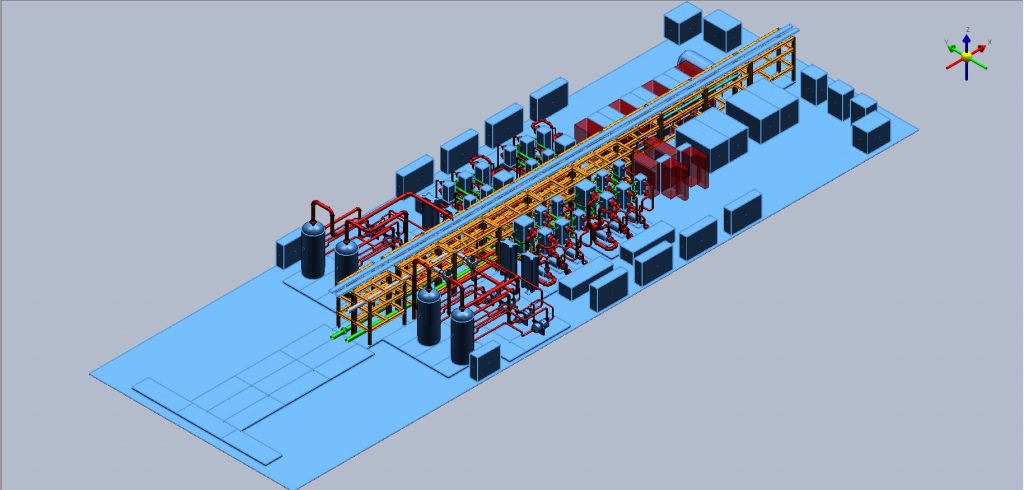
Conceptual design of the cryogenic cooling system for the large DUNE detector modules. Image: Air Products
Keeping the liquid nitrogen cold is more complex. During operation, the liquid nitrogen in the refrigeration system warms and boils off as nitrogen gas. Instead of cooling the nitrogen with an even colder material, the nitrogen gas will be recondensed through a series of pressure changes, taking advantage of proprietary turboexpander technology and the Joule-Thomson effect. When a gas is significantly compressed and then forced through a small opening, like a valve, and allowed to expand, the gas cools. If a gas is compressed, cooled, and then expanded in this way multiple times, it will eventually become cold enough to liquify. This method is well known and has been used for more than 100 years. Fortunately, it has become more efficient as technology has advanced.
“You could do the same with the argon,” said David Montanari, the deputy project manager for the Far Detector and Cryogenics Infrastructure Subproject. “The problem is the purity requirements for the argon don’t allow us to,” he said. The argon in the detectors has to reach purities of parts per trillion (impurity concentrations must be less than a trillionth of a percent), which is not possible with the compression-expansion method of gas liquification.
Air Products will be responsible for engineering, manufacturing and installing the entire liquid nitrogen cryogenic system. Integral to this cryogenic system is the incorporation of modular compression technology used to compress the nitrogen gas and turboexpanders used to expand and cool the nitrogen. The system will also have the added capability of generating its own nitrogen using Air Products’ proprietary membrane technology. The membrane system uses hollow-fiber technology to extract high-purity nitrogen from compressed air.
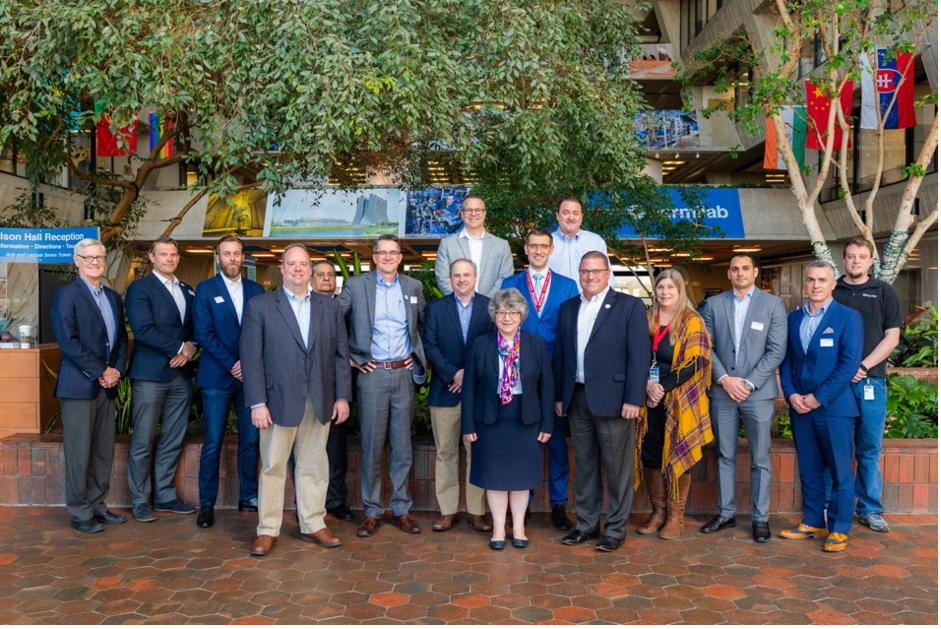
Participants from the project’s kick-off meeting, with representatives from Air Products and the LBNF team, gather in Fermilab’s Wilson Hall with Fermilab Director Lia Merminga (center, front). Photo: Ryan Postel, Fermilab
When the engineering phase is completed, the company will manufacture the system at one of its facilities, then dismantle it so that it can fit down the 5-foot-by-13-foot shaft opening and be taken piecewise a mile underground and into the newly excavated LBNF caverns that will house DUNE.
From an engineering perspective, the liquid nitrogen system is unique, it is one of a kind,” said Montanari. “It’s unique from an industry perspective, too. They have never built such a system underground because nobody builds anything under the ground in the industry; there’s no need to.”
The engineering effort to produce the final system is expected to take about 10 months. After the design is approved, the system will be manufactured and installed, ultimately coming online in the 2026 timeframe. Once operational, the DUNE far detectors are expected to be the largest underground cryogenic system in the world.
Find more information about the cryogenics of the LBNF/DUNE far detectors here.
Fermi National Accelerator Laboratory is supported by the Office of Science of the U.S. Department of Energy. The Office of Science is the single largest supporter of basic research in the physical sciences in the United States and is working to address some of the most pressing challenges of our time. For more information, please visit science.energy.gov.


